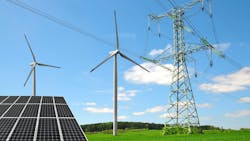FERC's New Rule Emphasizes Protection Engineering
This past summer, the Federal Energy Regulatory Commission issued Order No. 2023 that will expedite the integration of new sources of generation – in particular wind, solar, and battery facilities – onto the grid. Order No. 2023 spells out requirements that accelerate interconnection studies to mitigate project backlogs that have reached historic levels.
Project bundling replaces one-at-a-time interconnection studies and firm deadlines replace “best effort” timeframes. These and other changes, while driving decarbonization goals, press matters of grid modernization and system reliability that will significantly impact protection engineers. Connecting utility-scale, non-synchronous renewables to the grid puts unusual circumstances – multi-project caseloads with deadlines – into their workflow whether they’re ready or not.
The Dilemma
Developing protection schemes is complex enough already without factoring for wind and solar renewables. The operational characteristics of these inverter-based power sources force several design considerations to overcome issues such as intermittency, different system voltage requirements, and fault currents that are so low they’re virtually indiscernible from normal system conditions. Perhaps new advancements in power system components could mitigate these concerns, but real-world field experience that can help guide decisions might be limited with technologies that are still emergent.
Adding to the challenges of integrating renewables is the fact that NERC PRC standards already press protection engineers with compliance responsibilities that FERC Order No. 2023 requirements only exacerbate.
Reliability, Resilience, and Renewables: A New Chapter
FERC's regulatory framework with Order No. 2023 will deter project attrition, instilling investor confidence in renewables as sustainable, long-term investments. Protecting ROI will take an adaptive paradigm of strategic technology updates which will be key to not only overcoming protection engineering challenges, but also to increasing efficiency on the path forward.
Interconnecting renewables is one thing, restoring system performance following unplanned outages is another. Either circumstance demands protection engineering that drives resiliency as much as reliability. Revisiting protection philosophies isn’t a bad idea in the face of network infrastructure changes that will happen rapidly as renewable energy comes online and comprises an even greater portion of the U.S. energy portfolio. Having a philosophy instilled with ideation for the digital transformation of protection (and automation, communication, and control) systems can guide the right selection of upgrades for routine maintenance and disaster recovery now, and compliance reporting later on.
Integrating wind and solar generation sources can hasten grid modernization project by project, but the question on whether advances like adaptive, self-healing networks, or even entirely virtualized protection and control, will be integrated at scale remains to be seen. Plenty of intelligent electronic devices (IEDs) offer capabilities in need of opportunities within protection scheme designs. Getting there is fraught with usual matters of interoperability and cost on top of additional time and focus away from usual responsibilities toward learning and trialing new applications. Nonetheless, if ever there were a time for strategic investments in protection engineering, from recruiting talent to improving operations and resourcing R&D, it’s now.
Utilizing new network components strengthens the case for adopting modern protection engineering software tools that offer increased computational horsepower and handle relay and IED settings data from existing platforms. Such automation and efficiency will pay dividends getting interconnection studies done on time per FERC Order No. 2023 amid other protection engineering responsibilities per NERC PRC-027, for instance.
Responding Effectively
The grid is expected to double by 2050. To integrate renewables and other new sources of generation, utilities face transmission system expansions on top of revamping an aging grid. Federal regulations already factor into their decision-making, but multiple challenges – targeted cyberthreats, costs and deadlines – always remain.
System protection will see an outsized share of changes brought on by emerging digital and virtual concepts that promise unprecedented reliability and resiliency. Implementing increased automation of protection systems is difficult to imagine, let alone take seriously against the inertia of tried-and-true approaches to engineering, testing and maintenance. However, considering the recurring nature of routine maintenance and compliance responsibilities, utilities will look for efficiencies where they can, and invest capital in vetting workable alternatives that could result in savings in the long run.
The game within decarbonization is the rapid transformation of protection engineering into a data science field at the front edge of modern electric power delivery. It will be protection engineers leading our monumental shift to a more intelligent power grid that sustains renewable energy contributions flawlessly. How far automation can take us remains to be seen, but supporting protection engineers with tools that help them standardize the data they work with will go a long way toward helping them find efficiencies now when they need them most.
The challenges are many. Collaborating over a proactive protection engineering strategy is a good first step. Backing that up by committing resources for tools and the upskilling protection engineers need today will pay big returns tomorrow where new challenges await. The key is to view protection engineering as the critical piece of effective interconnection studies regarding renewables and grid modernization as a result.
About the Author
Joe Stevenson
Joe Stevenson is the Product Marketing Manager for Doble Engineering
